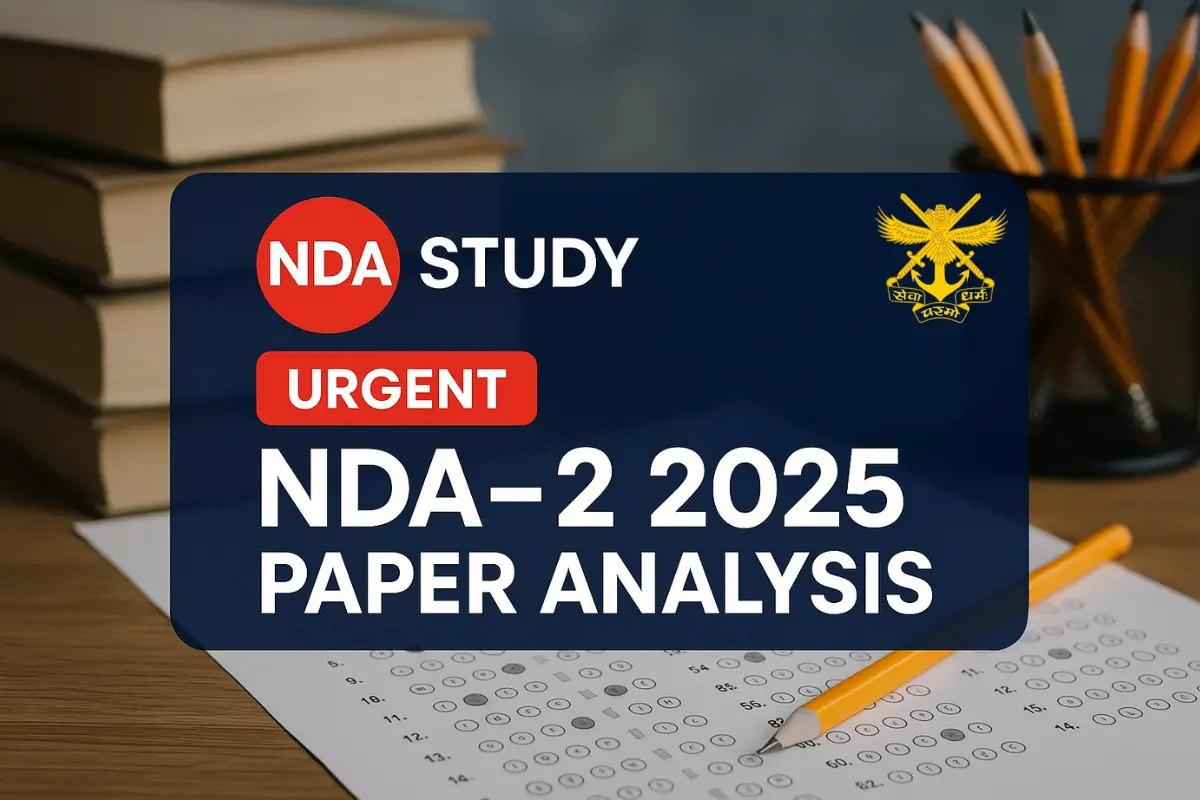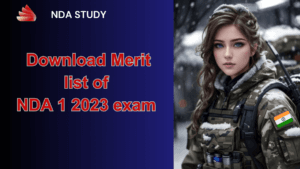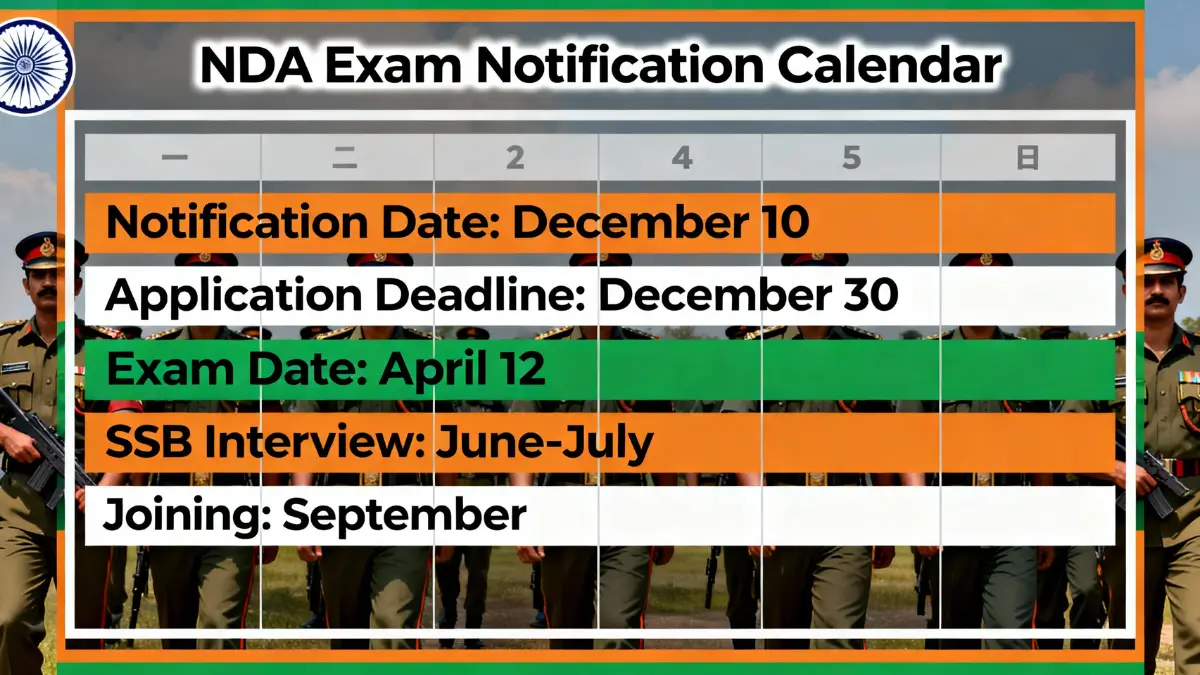Over 250,000 defence aspirants appeared for the NDA-2 2025 exam on September 14, 2025, making it one of the most competitive defence recruitment events of the year. The NDA 2 2025 Paper Analysis shows that approximately 200,000 to 250,000 candidates actually took the test out of nearly 500,000 to 600,000 registered students, reflecting a strong desire among young Indians to serve the nation.
The UPSC NDA September 2025 exam was conducted smoothly in two shifts across 78 cities. The Mathematics paper took place from 10:00 AM to 12:30 PM, followed by the General Ability Test (GAT) from 2:00 PM to 4:30 PM, allowing candidates sufficient rest between the two challenging sessions. According to key details in the NDA 2 2025 cut-off & Paper Analysis, the exam featured a total of 270 questions worth 900 marks—120 questions in Mathematics (300 marks) and 150 questions in GAT (600 marks). The exam employed negative marking, assigning -0.83 marks for incorrect answers in Mathematics and -1.33 marks for wrong answers in GAT.
Early reports suggest that the difficulty levels were moderate to tough, particularly in Mathematics, while GAT maintained a balanced level of difficulty. Predicted cutoff marks for NDA 2025 are expected to be around 350 to 385 marks, which will determine which candidates advance to the prestigious SSB interview round for the 406 available positions in India’s armed forces.
Mathematics NDA 2 2025 Paper Analysis
The NDA mathematics paper 2025 presented a balanced yet challenging examination that tested candidates’ conceptual depth across key mathematical domains. According to comprehensive student feedback and expert analysis, the September 14 2025, NDA exam analysis reveals a moderate to tough difficulty level that demanded strong foundational knowledge and strategic problem-solving abilities.
Topic-wise Question Distribution
The UPSC NDA-2 paper pattern analysis shows strategic distribution favouring high-weightage topics. Probability dominated with 15 questions, making it the highest contributor, followed by Matrices and Determinants with 10 questions and Trigonometry with 9 questions. This distribution aligns with traditional NDA patterns where Algebra and Vector Algebra collectively contribute 40 questions (33% weightage), Calculus topics account for 20 questions (17% weightage), and Analytical Geometry covers 20 questions (17% weightage).
Key topic breakdown includes Permutation and Combination (7 questions), Relations and Functions (7 questions), Sequence and Series (7 questions), and Quadratic Equations (6 questions). Vector Algebra and 3D Geometry contributed significantly with 6 and 5 questions, respectively, while Statistics and Probability maintained moderate representation with 6 questions total.
Quick preparation strategy for aspirants:
Focus intensively on Probability, Matrices, and Trigonometry, as these three topics alone contribute 34 questions (28% of the paper). Master NCERT concepts in Algebra and Calculus, as they form the foundation for 60% of questions.Difficulty Level Assessment
Student feedback consistently rates the NDA-2 2025 shift 1 difficulty level as moderate to tough, with many candidates finding Calculus and Integration particularly challenging. The NDA mathematics GAT paper review 2025 indicates that 40% questions were easy, 50% moderate, and 10% tough, creating a well-balanced assessment that rewarded thorough preparation.
Expert analysis reveals that computational complexity increased compared to previous years, with multi-step problems in Differential Calculus and Integration consuming significant time. However, Algebra and Trigonometry sections remained relatively accessible, allowing well-prepared candidates to secure good scores. The negative marking system (-0.83 marks) added strategic pressure, making accuracy crucial for optimal performance.
Compared to previous years' mathematics papers, this examination maintained consistent difficulty trends while emphasising conceptual understanding over rote memorisation, aligning with UPSC's evolving assessment philosophy.
General Ability Test (GAT) NDA 2 2025 Paper Analysis
The NDA 2 2025 Paper Analysis highlights a balanced yet demanding 150-question GAT section, designed to evaluate candidates’ linguistic skills, general awareness, and scientific aptitude. This critical component carried 600 marks and was conducted from 2:00 PM to 4:30 PM on September 14, 2025. According to the UPSC NDA September 2025 exam analysis, the GAT offered a slightly easier challenge compared to Mathematics, rewarding thorough preparation and quick thinking.
English Section Review
The English segment consisted of 50 questions, focusing on grammar, vocabulary, and reading comprehension. Students rated this part as “simple to attempt”, thanks to straightforward sentence completion, idiom usage, and error-spotting exercises. Key topics included:
- Sentence Completion: Testing context-based word selection
- Idioms and Phrases: Assessing familiarity with common expressions
- Error Spotting: Identifying grammatical and syntactical mistakes
This section allowed aspirants to secure a solid base of marks with minimal time investment, boosting confidence for the subsequent GK portion.
General Knowledge Breakdown
The GK section featured 100 questions spanning current affairs, history, geography, physics, chemistry, and sports. Emphasis was placed on:
- Current Affairs: International relations, environmental policies, major sports events
- History & Geography: Indian independence movement, world geography fundamentals
- Science: Conceptual physics questions on mechanics and thermodynamics, and direct NCERT chemistry queries on atomic structure and chemical bonding
Students appreciated the clear, factual nature of science questions and found environmental issues and global news particularly relevant. This NDA mathematics GAT paper review 2025 suggests that strong reading habits and regular newspaper updates were key to excelling in the GK section. With a balanced mix of easy and moderate questions, the GAT rewarded well-rounded preparation, complementing the tougher Mathematics paper and influencing the overall NDA 2025 expected cut-off marks.
Expected Cut-off Marks for NDA-2 2025
Building on the NDA 2 2025 Paper Analysis, expert predictions for the NDA 2025 expected cut-off marks reflect the exam’s moderate-to-tough difficulty and historical trends. The following estimates will guide aspirants on the target scores needed to advance.
Written Exam Cut-off Predictions
For the written exam, a total score between 350 and 385 out of 900 is anticipated as the qualifying threshold. Category-wise projections are:
- General Category: 350–360 marks
- OBC Category: 345–350 marks
- SC/ST Categories: 310–330 marks
These ranges consider the September 14 2025, NDA exam analysis, where the Mathematics paper’s moderate-to-tough rating and balanced GAT performance influence overall scoring patterns. The minimum qualifying requirement of 25% in each paper (75 marks in Mathematics, 150 marks in GAT) ensures candidates demonstrate consistent competency across sections. The cut-off predictions also account for the normalisation process across multiple shifts and varying difficulty sets, aligning with UPSC’s commitment to fairness. Historically, a rise in cut-offs by 5–10 marks compared to NDA-1 2025 is expected due to slight upticks in average scores across both papers.
Final Selection Cut-off (Written + SSB)
The final selection cutoff, combining written exam and SSB scores out of 1800, is projected at 710–720 marks. This composite threshold reflects:
- Written Exam Contribution (900 marks)
- SSB Interview & Psychological Tests (900 marks)
Strong performance in the SSB component can raise marginal candidates above the final cutoff, emphasising the interview’s weight in assessing leadership potential and personality. Comparing with previous cycles, the final cutoffs have steadily increased by 5–8 marks annually, driven by improved written scores and competitive SSB outcomes. The UPSC NDA-2 paper pattern analysis suggests that aspirants scoring near the written cut-off must excel in personal interviews, group tasks, and psychology tests to secure a coveted academy berth.
Good Attempts and Accuracy Requirements
To excel in the NDA 2 2025 Paper Analysis, a strategic balance between attempts and accuracy is essential. With negative marking in both papers, candidates must optimise their question attempts to maximise scores while minimising penalties.
Mathematics Good Attempts
For the Mathematics section, attempting 50–60 questions is ideal, with 55–65 attempts recommended for well-prepared aspirants. Given a -0.83 penalty for each wrong answer, maintaining at least 80% accuracy is crucial—roughly 44–52 correct answers out of 55 attempts. Time management plays a pivotal role: allocate the first 60 minutes to high-weightage topics like Probability, Matrices, and Trigonometry, then use the remaining 30 minutes for quicker Algebra and Coordinate Geometry questions. This structured approach ensures that calculation-heavy problems receive adequate time without compromising accuracy.
GAT Optimal Attempts
In the General Ability Test (GAT), candidates can confidently attempt 80–90 questions, with an optimal range of 58–65 high-confidence answers. The factual nature of English and GK questions allows for higher attempt rates, but the -1.33 marking for incorrect responses demands caution. Focus first on the English section questions, which are comparatively simpler, then tackle current affairs, history, and science segments. Prioritise questions with clear-cut answers—such as direct NCERT chemistry facts and straightforward sports or environmental queries—to safeguard accuracy. By balancing quick wins with selective risk-taking on moderate questions, aspirants can maximise their GAT scores without suffering heavy negative marking.
Comparison with Previous NDA Exams
Analysing NDA exam trends reveals that NDA 2 2025 Paper Analysis aligns closely with patterns observed in NDA-1 2025 and past years, yet introduces subtle shifts in difficulty and scoring. The September 14 2025, NDA exam analysis indicates consistency in exam structure—270 questions totalling 900 marks—while reflecting a gradual uptick in complexity, especially in the Mathematics section.
In NDA-1 2025, the Mathematics paper featured a slightly lower proportion of high-weightage topics like Probability and Matrices, resulting in a modest cut-off range of 340–370 marks for the written exam. By contrast, NDA-2 2025 elevated question rigour in Calculus and Analytical Geometry, prompting experts to predict a higher qualifying bracket of 350–385 marks. This trend suggests that UPSC is incrementally challenging aspirants’ problem-solving skills, emphasising conceptual clarity over rote learning.
Cutoff evolution shows a steady climb: from 330–360 in 2023 to 345–375 in NDA-1 2025, and now expected to be 350–385 in this cycle. This stable yet upward trajectory underlines aspirants’ improving performance alongside rising competition. Similarly, the GAT section has remained balanced but introduced nuanced GK questions on contemporary environmental policies and international affairs, slightly impacting average scores.
Overall, the previous year comparison underscores a deliberate shift toward more analytical questions without drastically altering overall cutoffs, maintaining fairness while rewarding deeper understanding. Continuous monitoring of these UPSC NDA-2 paper pattern analyses will help future candidates adapt to evolving examination standards.
1. What was the overall difficulty level of NDA-2 2025?
The NDA-2 2025 exam struck a balance between moderate and tough sections. Mathematics was rated moderate to challenging due to complex Calculus and Probability problems, while the GAT section remained accessible with straightforward English and GK questions.
2. Which topics carried the highest weight in the Mathematics paper?
Key high-weightage topics included Probability (15 questions), Matrices & Determinants (10), Trigonometry (9), and Algebra & Vector Algebra combined (40 questions). Focusing on these areas can boost scores significantly.
3. How many good attempts are recommended for each section?
Aim for 55–65 correct attempts in Mathematics with 80% accuracy, and 58–65 high-confidence answers in GAT to balance risk and maximise marks under negative marking rules.
4. What cut-off marks should aspirants target for NDA-2 2025?
For the written exam, aim for 350–385 out of 900 marks. Category-wise targets are: General: 350–360, OBC: 345–350, SC/ST: 310–330. For final selection (Written + SSB), target 710–720 out of 1800 (NDA Study projections).
5. What’s the next step after clearing the written exam?
Qualified candidates proceed to the 5-day SSB process, starting with OIR & PPDT, then group tasks, psychology tests, and personal interviews. Begin practising TAT, WAT, and SRT exercises and mock group discussions immediately (NDA Study Research & Analysis Wing).
What’s Next? SSB Preparation Strategy
Candidates who clear the written exam cut-offs must now gear up for the SSB interview, a five-day selection process evaluating personality, leadership, and psychological aptitude. Typically scheduled 4–6 weeks after the written results, the SSB consists of two stages: Stage I (OIR and PPDT) and Stage II (interviews, group tasks, psychology tests, and conference).
To excel, focus on these key areas:
- Personality & Communication: Practice personal introductions and storytelling in front of peers to enhance confidence and clarity.
- Group Tasks & Discussion: Engage in mock group discussions on current defence topics and environmental policies to sharpen teamwork and analytical skills.
- Psychological Tests: Familiarise yourself with the Thematic Apperception Test (TAT), Word Association Test (WAT), and Situation Reaction Test (SRT) by solving sample prompts daily.
- Interview Preparation: Stay updated on international affairs and defence news, and rehearse responses to common questions about your background, motivations, and leadership experiences.
Recommendation: We currently only offer SSB Preparation Materials. For SSB strategies and updates, check out SSB Crack and Major Kalshi Classes.
For comprehensive guidance, refer to the NDA Study’s SSB Preparation Resources, which include detailed strategies, practice papers, and expert tips designed to complement your NDA-2 2025 Paper Analysis insights. Diligent preparation in these areas can significantly boost your chances of securing a coveted academy berth.
Stay Tuned & Stay Connected!

![UPSC NDA result 2025 out: Direct link, Cut Off & PDF [Download] 2 UPSC NDA result 2025 out: Direct link, Cut Off & PDF [Download]](https://ndastudy.com/wp-content/uploads/2025/05/UPSC-NDA-result-2025-300x169.webp)






